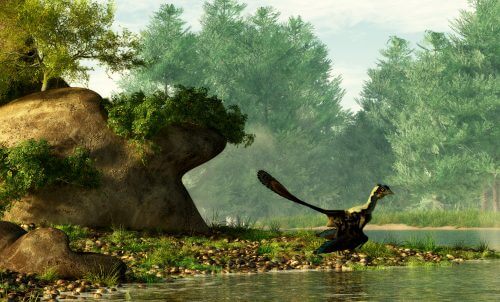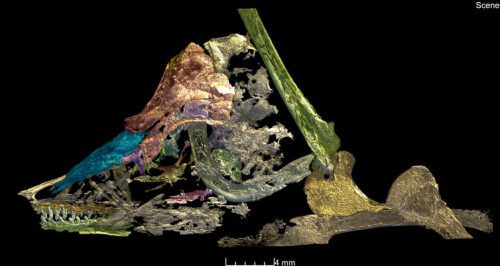A flying dinosaur fossil known as Archeopteryx from China purchased by a private collector was studied using a synchrotron, and it turned out that it predates the Archeopteryxes that were discovered before it, and is actually a missing link between them and the dinosaurs. It is believed that the birds of today evolved from them later

Author: John Nudds, Senior Lecturer in Palaeontology, University of Manchester
Perhaps one of the most well-known fossils in the world is Archeopteryx. With beautifully preserved feathers, it has long been considered the first recorded fossil bird, and is often called "the symbol of evolution." Only a handful of details of this fossil bird have ever been revealed, so its elusiveness added to its charms.
But is this really the first bird and could it really fly? Given that we now know that birds are descended from dinosaurs, was Archeopteryx in fact just another small feathered dinosaur?
My colleagues and I had the rare opportunity to examine the Archeopteryx skeleton using one of the most powerful synchrotrons in the world, a type of particle accelerator, similar to an X-ray machine, but tens of billions brighter than the ones in the hospitals. We were able to see what was in the depths of the rock and uncover bone fragments that had never been seen before. What we discovered surprised us: it was a completely new species of Archeopteryx.
The first Archaeophryx fossil was discovered in Jurassic rocks in Bavaria in the summer of 1861, just two years after Darwin's On the Origin of Species was published. He seems to be one of Darwin's "missing links", in the connection between reptiles and birds, especially between dinosaurs and birds.
It certainly looks like a chicken, with fine feathers preserved on its wings and a fan-shaped tail. It also had a "furcula" bone, just like the one found in roast chicken. And these two features were considered at the time to exist only in birds. But Archaeopteryx also had some features very characteristic of reptiles such as a long, bony tail, and a jaw full of very sharp teeth - and it seems as if it is an animal that is in an intermediate stage between the two groups.
The second fossil was found in 1876, but since then only ten more fossils have been discovered, one of which is lost and others have only fragments.
Despite more than 150 years of research, we still have a lot to discover about this primitive chicken. Most of the controversy revolves around the question of whether Archeopteryx could fly, the consensus being that it was at best flying or hovering slightly and low.
The eighth fossil discovered was one of the least known fossils. It was found by a private collector in a quarry near Daiting in Bavaria, Germany, in the early 1990s, and changed hands several times before being sold cheaply to another private collector in the belief that it was a common pterosaur. It later changed hands again for millions of dollars. When the first discoverer learned this, he put an end to the obligation by jumping from the quarry.
The new owner, perhaps out of guilt, was very secretive about his purchase, and the scientific community didn't know about this fossil until 1996 (hence its nickname, "the ghost"), when it was briefly displayed at the Natural History Museum in Bamberg, Germany. Then, in 2009, dinosaur collector Raymond Albersdorff from Bavaria acquired the fossil (in 2011 he allowed our research team to study it).
the ugly bird
It was not well preserved, and we called it "the ugly bird", since the bones were detached after her death, mixed together and crushed. The lower part of the body was completely missing. But we took it to Grenoble, to the European Synchrotron Radiation Facility (ESRF), where we were able to perform virtual dissections of the skeleton, and piece together bone fragments that broke when the animal died 150 million years ago.
All fossil specimens of Archeopteryx have been classified as a single species, Archeopteryx lithographica, but it looks different. The rest of the samples were collected from another layer known as the Solnhofen Formation. Our fossil was collected from the Mornheim Formation, which lies above the Solnhofen Formation and is considered to be half a million years younger than it.
We noticed for the first time that the bones of the skull were fused together. Then we noticed that the porcula has a hand-like appendage, which in modern birds is associated with the powerful flight muscles. None of these features were seen in lithographic archaeopryx. An enlarged opening in one of the bones of the shoulder girdle (called the "crachoid") is a hint of a large nerve passing through this bone and further evidence of a stronger wing.
But our biggest surprise was when we noticed that the bones of the wrist were fused together - another feature of modern birds known as "carpo-metacarpus". This fusion provided a rigid structure that allows the bird to beat its wings hard.

This feature was also found in Archaeopteryx lithography in place of the flexible arm seen in its dinosaur ancestors. It was clear that our specimen shows many of the features found in modern flying birds, but Arthopatrix lithographica is a little pale and low. We discovered a new species for science, and named it Otarchiopatrix albersdorff after its owner who saved it from anonymity.
Every time a missing link is discovered, it creates two missing connections - what came before it, and what came after it. In this case, what came before Archeopteryx was discovered in 1996 with the description of feathered dinosaurs in China. Our new species are what came next. This confirms that Archaeopteryx was the first bird and not just one of several species of feathered dinosaurs as other researchers have recently suggested. Our study places Archaeophryx as the first bird.
For news in THE CONVERSATION
for the scientific article
More of the topic in Hayadan:

4 תגובות
Ed
A duck has no feathers and never had. Mammals are divided into three: placental mammals which are the majority, marsupial mammals and bib mammals. Everyone has fur and everyone has a nursing mother.
There have been scams in paleontology in the past and also many mistakes. I also think that the term "missing link" is wrong and creates an unnecessary sensation.
But this is a science like any other science and almost all of it does describe the past and shows the correctness of what we believe in today. There are millions of fossils and not one of them contradicts evolution. Our knowledge is only expanding and sharpening, and overall the situation today is excellent.
Miracles,
There is no doubt that the starting point is the current definition of "bird". After all, the entire evolutionary examination is retrospective, from the present to the past.
It is unlikely to me that the definition you proposed - "feathered animal" is a sufficient and exhaustive definition. A duck has feathers, but it is not a bird. I assume that the sufficient definition should include factors of central features - physical, as well as belonging to a developmental chain at the biomolecular-genetic level.
I did not raise my previous response except because I felt that the "research" discussed in the article revealed a speculative-marketing face under the guise of accepted scientific methodology. The result of this kind of "research" is the creation of scientific lies, and this has consequences regarding the cultivation of a culture of lies in general. This is a phenomenon that exists in science, but there are scientific fields that suffer especially from this phenomenon - paleontology for example.
Ed
If you look at the existing species (that is, those that are not extinct) then you can define a bird precisely. A possible definition is a feathered animal, and this is a sufficient and exhaustive definition.
But, if we also look at extinct species, then the definition is not possible, or it is arbitrary.
And this is true not only for birds. In evolution there is a developmental sequence and it is not possible to define when the bird class began.
I will give you an example that illustrates the problem. Every bird has a mother, and only one mother. On the other hand, each mother can have multiple female offspring. Therefore, if we go back in time then we will inevitably reach one bird that is the ancient mother of all birds alive today.
But, the identity of this particular bird could change in the future!
Since the article does not define what, in his opinion, a "bird" is - it is difficult to understand why exactly the eighth fossil, which is supposed to be a species of Archeopteryx, makes Archeopteryx the "first bird". It does have some signs of a bird, but it also has signs of a feathered dinosaur. The fact that it may "fly", it still does not mean that it is a bird. Beyond that, it is possible that the eighth fossil is not a species of Archeopteryx, but another creature, perhaps later or perhaps earlier in time, that was unable to breed with Archeopteryx. Without a biomolecular test it is difficult to make clear determinations on the matter, and even the diagnoses on a fossil found in broken bones may be speculative and wrong.
When there is no sufficient conceptual perspective, and when the empirical base is fragmentary and ambiguous, it is possible to reach extreme conclusions. This is useful for publicity, but not necessarily for scientific accuracy.